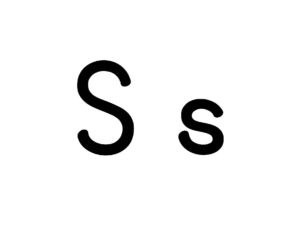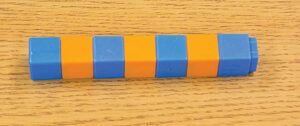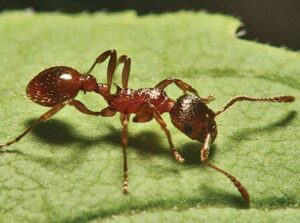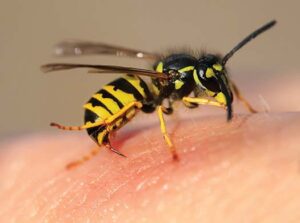Phonological awareness, Letter knowledge
Children will segment words into syllables. Children also will identify and name the letter S.


Review:
Last week we learned how to divide our names into syllables. We know the word divide means to separate or break up something into smaller parts. Remember, each part of a word is called a syllable.
Today we are going to play a syllable game. Together we will say each of our names. Then we will clap the syllables in our name three times.
Let’s practice with _____’s name.
[Invite a volunteer child to say his/her name. Display the child’s name card divided into syllables. Say the name again as you speak slowly and divide it into syllables. Clap once for each syllable. Ensure that your claps are slow and deliberate to help children understand that each syllable gets one clap.
Invite children to say together the child’s name as they clap the syllables.]
Now we will whisper _____’s name while we clap each syllable. Let’s use our listening ears as I show you how.
[Whisper the child’s name. Whisper the name again as you speak slowly and divide it into syllables. Clap once for each syllable. Use a deliberate clap.
Then invite children to whisper together the child’s name as everyone claps the syllables.]
Now we will only move our mouth while we clap each syllable. Let’s use our looking eyes as I show you how.
[Silently enunciate syllables in the child’s name with only mouth movement. Silently enunciate the name again as you move your mouth slowly and divide it into syllables. Clap once for each syllable. Use a deliberate clap.
Then invite children to silently enunciate together the child’s name as everyone claps the syllables.]
When I point to you, please hold up your name card and say your name out loud. Then we will clap your name while we all say your name together.
[Move from child to child as you together clap the child’s name in three ways as described above: while saying the name, while whispering the name, while only moving your mouth. Continue until you’ve clapped each child’s name.]
 Now we are going to learn a different letter of the alphabet.
Now we are going to learn a different letter of the alphabet.
[Display letter S card.]
Does anyone know the name of this letter?
This is the letter S. We can write the letter S in two ways. We can write the letter S like this.
[Demonstrate writing an uppercase S at the top of a chart paper.]
This is an uppercase S.
We can also write the letter S like this.
[Demonstrate writing a lowercase s at the top of a chart paper.]
This is a lowercase s.
We are learning about syllables. The word “syllable” begins with the letter s. I will write this word on our chart. I am going to write the word “syllable” with a lowercase (small letter) s.
[Say each letter as you write the word. Emphasize s.]
Let’s all say the word “syllable.”
[Invite a volunteer child to point to the letter s in the word “syllable.”]
Let’s look at the very first letter of our name. Pop up if you have the letter S at the beginning of your name. Remember, names begin with an uppercase (big) letter.
[Encourage children to look at their name cards. Say the first names of children who have an S at the beginning of their name. If there are children whose name begins with the letter S who do not stand, point to the letter S in their name card. Compare the letter S in their name as you hold the letter S card next to their name card.
If no one in the group has a first name beginning with the letter S, say “No one popped up because no one has a name that starts with the letter S.” Encourage children to look at the list of children’s first names. Point to some first letters of names. Explain that no one’s name begins with the letter S.
If a child indicates there is a letter S in his/her name, but not at the beginning of the name, fully recognize the name and invite the child to pop up. Day 4 gives attention to the letter s that appears somewhere else in a child’s name.]
Today we clapped our name in three ways. We clapped while saying each name, while whispering each name, and while only moving our mouth.
We also learned about the letter S. What is a word that begins with the letter s? (syllable)
Extra support
Enrichment
Provide *letter picture cards used for letters B, C, O, A, and X. Encourage children to say each word and clap its syllables.
*Printables provided
Invite children to join you in clapping the number of syllables in each child’s last name. Write 2–4 syllable words on index cards and invite school-age children to cut apart words based on the number of syllables. Example: bas/ket.
Pattern knowledge
Children will understand how to make an ABAB pattern.


New:
Review:


Yesterday we learned about patterns. Do you have a pattern on your clothes today? What is a pattern? (something that repeats itself )
[Find and discuss any patterns found on children’s clothing. Say each pattern together as you point to each element of the pattern.]
Today each of us is going to work with a partner to make a pattern. We will use blue and orange Unifix® cubes to make a simple pattern. A simple pattern uses two things that repeat themselves.
One person will have blue cubes and the other person will have orange cubes.
 [Give each child in the pair 10 cubes of one color. If there is an odd number of children, pair one child with yourself.]
[Give each child in the pair 10 cubes of one color. If there is an odd number of children, pair one child with yourself.]
Each of us will take turns making a pattern with our cubes. One person in your pair will put a cube on the table and then the other person will attach his/her color. Then the first person will attach his/her color and then the second again. Let me show you.
[Demonstrate how to add the two colors in the pattern, alternating the colors one at a time.]
What color cube goes next? Why?
[As you make the pattern, continue to ask children to say what color goes next. Ask children how they know. Continue the pattern until you have used all of the cubes.]
Now it is your turn to try! When we finish making our cube pattern, we can point to the cube at one end and say the pattern together with our partner.
Today we made a pattern with a partner. We used two colors of cubes to make our pattern. Let’s say a pattern together beginning with blue. Blue, orange, blue, orange, etc.
Extra support
Enrichment
Supply Unifix® cubes. Encourage children to create more simple patterns. Display the *large numeral two and invite children to place cubes on the numeral in a pattern.
*Printables provided
Take children on a walk outside to look for simple patterns. Encourage children to find patterns on the outside of your own home or other houses. Examples: bricks on a house, lines on a sidewalk.
Knowledge of living things
Children will broaden their understanding of parts of an insect.


New:
Review:
Be Prepared: Children will begin using science journals during today’s activity. Science journals will be used throughout the remainder of the year. A simple notebook or approximately 20 sheets of paper stapled together can be used as a science journal. If you make journals by stapling pieces of paper together, you may wish to create a cover on colored paper and/or invite children to design a cover. Invite children to write as much of their first name as they can on the cover of their journal.
Yesterday we learned that an insect is an animal with six legs. How does an insect use its legs? (to move around, to make sounds)
We also learned that an insect’s legs and wings are attached to the middle part of its body. Today we will learn more about insects.
Let’s put our hand on the top part of our body.
[Point to your head.]
What is this part of our body called?
An insect’s head is at the front of its body. An insect uses its head to eat and see.
Please point to your nose. What do we do with our nose? (smell)
 Insects do not have a nose. An insect uses its antennae to help it smell and feel things.
Insects do not have a nose. An insect uses its antennae to help it smell and feel things.
[Point to antennae in the picture of an ant.]
An insect’s antennae are long and thin. They are attached to the insect’s head.
Let’s pretend we are insects with antennae on our head. We can pretend straws are our antennae.
[Hold the two straws above your head as you pretend they are antennae.]
What can we pretend to do with our antennae? (smell, feel things)
[Give each child two straws. Invite children to hold the straws above their head as they pretend to smell and feel things with their “antennae.” Collect straws after a brief period and invite children to sit on the floor.]
 An insect also has a stomach. An insect’s stomach is at the back of its body.
An insect also has a stomach. An insect’s stomach is at the back of its body.
[Point to the abdomen (back part) of the body in the picture of a wasp.]
We also have a stomach. Let’s put our hand on our stomach.
Some insects use their stomach to breathe!
What do we use to breathe? (mouth)
Some insects have a stinger. A stinger is a sharp, pointed part of an animal that can hurt another living thing. Insects use their stinger to protect themselves against things that may hurt them.
Today we will begin using something to help us learn more about the things we study. Each of us will have a science journal.
What do you think a science journal might be?
A science journal is a notebook that we can draw and write in. We can use our science journal to draw pictures of things we learn about and to write about things.
[Pass out journals to children.]
We will use our science journals many times. Scientists keep a journal to record information. Remember, we record something when we write it down.
What do you think we might draw or write about in our science journal today?
[Help children find the first page of their science journal.]
We are going to draw a picture of an insect. You can draw any type of insect you want or a part of an insect’s body.
[Provide pictures of insects for children to use if they wish. Children should not be expected to copy or produce a replica of an insect or insect part. Offer suggestions of parts of an insect children may wish to draw. Examples: legs, antennae, stomach, head.
Label children’s drawings as they dictate.
Children may wish to show and talk about their drawings with other children.]
Today we learned that insects have a head and antennae. How do insects use their antennae? (smell, feel things) We also learned that insects have a stomach. Where can we find an insect’s stomach on its body?
[Encourage a volunteer child to point to the stomach in the picture of the ant.]
We also drew a picture of an insect or part of an insect in our science journals.
Extra support
Enrichment
Make insect headbands with pipe cleaners or Wikki Stix®, large pom-poms, and plastic headbands. Attach a pom-pom to each of two pipe cleaners. Then attach the two pipe cleaners or Wikki Stix® to a headband. Encourage children to pretend to be insects. Remind children that insects use their antennae to smell and feel things.
Collect insects that children may find outside and keep them in a jar with small holes to permit air. Invite children to add rocks, leaves, and grass to make it seem more like “home.” Encourage children to observe the insects throughout the day. Be sure to release the insects at the end of the day.
Understanding Feelings
Social-Emotional
Skill and Goal
Emotion knowledge
Children will understand what it means to feel disappointed.
Materials
Needed
*Printables provided
Key
Concepts
New:
We are learning about many different kinds of emotions. Today we will talk about what it means to feel disappointed.
What are your ideas about what it means to feel disappointed?
[Display book illustration of feeling disappointed.]
[Describe some of the facial expressions and body postures shown by children. Invite children to notice how other children’s faces show disappointment.]
Let’s take a look at our poster and see if we can find the child who is feeling disappointed.
[Invite children to point out on the poster which children look disappointed. Discuss facial features that children associate with being disappointed.]
When we feel disappointed, we might feel better if we talk to someone about it. Telling someone about our disappointment might help us figure out what to do with our feeling. We could say to a parent something like, “I am really disappointed we cannot have a pizza tonight.” Maybe there is something else we could do. Or maybe we need to wait patiently for what we want or what we want to do.
Who could we talk to if we feel disappointed? (parents, friend, teacher, etc.)
We are going to use puppets to pretend to be disappointed. Who wants to volunteer to be the child puppet?
[Choose a volunteer and invite him/her to be the child puppet. Invite the volunteer to use the puppet and pretend to be disappointed. Give prompts if necessary. Example: Let’s pretend you were supposed to go to the park today, but your sister/brother isn’t feeling well so you can’t go. Show us by using the puppet how it would make you feel and what you might be thinking about. Interact by using the “adult” puppet to talk to the child puppet about their disappointment. Offer specific suggestions, such as: “Is there something else you could do instead?” Continue to role-play a different scenario with other child volunteers if time permits.]
Today we talked about how we might feel if we cannot do something we really want to do or have something we really want. What do we call this feeling? (disappointed) Everyone is disappointed sometimes. We learned how to feel better by talking to someone about how we feel.
Scaffolding Tips
Extra support
Enrichment
Center Activity
Invite children to use puppets to role-play things that might make them disappointed or excited. Examples: Going to a party, having to stay home on a rainy day rather than going swimming.
Family Child Care
Encourage children to talk to their families at pickup time about disappointment. Invite children to tell their families about what it looks and feels like. Encourage family members to share a time they were disappointed.